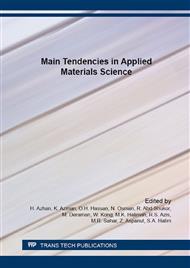[1]
L. Heijnen, G. Medema, Quantitative detection of E. coli, E. coli O157 and other shiga toxin producing E. coli in water samples using a culture method combined with real-time PCR, J. Water Health 4 (2006) 487–98.
DOI: 10.2166/wh.2006.0032
Google Scholar
[2]
K. Jiang, H. Etayash, S. Azmi, S. Naicker, M. Hassanpourfard, P. M. Shaibani, G. Thakur, K. Kaur, T. Thundat, Rapid label-free detection of E. coli using antimicrobial peptide assisted impedance spectroscopy, Anal. Method. (2015).
DOI: 10.1039/c5ay01917f
Google Scholar
[3]
T. Saxena, P. Kaushik, M. K. Mohan, Prevalence of E. coli O157: H7 in water sources: an overview on associated diseases, outbreaks and detection methods, Diagn. Micr. Infec. Dis. 82 (2015) 249–264.
DOI: 10.1016/j.diagmicrobio.2015.03.015
Google Scholar
[4]
M. Nayak, A. Kotian, S. Marathe, D. Chakravortty, Detection of microorganisms using biosensors–A smarter way towards detection techniques, Biosens. Bioelectron. 25 (2009) 661–667.
DOI: 10.1016/j.bios.2009.08.037
Google Scholar
[5]
T. Ahuja, I. A. Mir, D. Kumar, Rajesh, Biomolecular immobilization on conducting polymers for biosensing applications, Biomaterials 28 (2007) 791–805.
DOI: 10.1016/j.biomaterials.2006.09.046
Google Scholar
[6]
K. S. Ryder, D. G. Morris, J. M. Cooper, Role of conducting polymeric interfaces in promoting biological electron transfer, Biosens. Bioelectron. 12 (1997) 721–727.
DOI: 10.1016/s0956-5663(97)00039-0
Google Scholar
[7]
S. Bhadra, D. Khastgir, N. K. Singha, J. H. Lee, Progress in preparation, processing and applications of polyaniline, Prog. Polym. Sci. 34 (2009) 783–810.
DOI: 10.1016/j.progpolymsci.2009.04.003
Google Scholar
[8]
M. Jaymand, Recent progress in chemical modification of polyaniline, Prog. Polym. Sci. 38 (2013) 1287–1306.
DOI: 10.1016/j.progpolymsci.2013.05.015
Google Scholar
[9]
A. K. Sarker, J. D. Hong, Electrochemical reduction of ultrathin graphene oxide/polyaniline films for supercapacitor electrodes with a high specific capacitance, Colloid. Surface. A. 436 (2013) 967–974.
DOI: 10.1016/j.colsurfa.2013.08.043
Google Scholar
[10]
K. P. Kamloth, B. J. Polk, M. Josowicz, J. Janata, Photochemical tuning of field-effect transistor with polyaniline gate conductor, Adv. Mater. 13 (2001) 1797–1800.
DOI: 10.1002/1521-4095(200112)13:23<1797::aid-adma1797>3.0.co;2-7
Google Scholar
[11]
S. M. Reda, S. M. Al-Ghannam, Synthesis and electrical properties of polyaniline composite with silver nanoparticles, Adv. Mater. Phys. Chem. 2 (2012) 75–81.
DOI: 10.4236/ampc.2012.22013
Google Scholar
[12]
Shumaila, G. B. V. S. Lakshmi, M. Alam, A. M. Siddiqui, M. Zulfequar, M. Husain, Synthesis and characterization of Se doped polyaniline, Curr. Appl. Phys. 11 (2011) 217–222.
DOI: 10.1016/j.cap.2010.07.010
Google Scholar
[13]
Y. Tan, Y. Zhang, J. Kan, Synthesis and properties on polyaniline in the presence of nickel chloride. Express. Polym. Lett. 13 (2009) 333–339.
DOI: 10.3144/expresspolymlett.2009.42
Google Scholar
[14]
N. A. N. Azmy, H. Abdullah, N. M. Naim, A. A. Hamid, S. Shaari, W. H. M. W. Mokhtar, Gamma irradation effect on the structural, morphology and electrical properties of ZnO-CuO doped PVA nanocomposite thin films for Escherichia coli sensor, Radiat. Phys. Chem. 103 (2014).
DOI: 10.1016/j.radphyschem.2014.05.025
Google Scholar
[15]
H. Abdullah, N. M. Naim, N. A. N. Azmy, A. A. Hamid, PANI-Ag-Cu nanocomposite thin films based impedimetric microbial sensor for detection of E. coli bacteria, J. Nanomater. (2014), doi: 10. 1155/2014/951640.
DOI: 10.1155/2014/951640
Google Scholar
[16]
M. Valodkar, S. Modi, A. Pal, S. Thakore, Synthesis and anti-bacterial activity of Cu, Ag and Cu-Ag alloy nanoparticles: A green approach, Mater. Res. Bull. 46 (2011) 384–389.
DOI: 10.1016/j.materresbull.2010.12.001
Google Scholar
[17]
Y. K. Su, C. M. Shen, T. Z. Yang, H. T. Yang, H. J. Gao, H. L. Li, The dependence of Co nanoparticle sizes on the ratio of surfactants and the influence of different crystal sizes on magnetic properties, Appl. Phys. A 81, (2005) 569–572.
DOI: 10.1007/s00339-004-2713-z
Google Scholar
[18]
I. Saini, J. Rozra, N. Chandak, S. Aggarwal, P. K. Sharma, A. Sharma, Tailoring of electrical, optical and structural properties of PVA by addition of Ag nanoparticles, Mater. Chem. Phys. (2013) 1–9.
DOI: 10.1016/j.matchemphys.2013.02.035
Google Scholar
[19]
V. Dixit, J. C. Tewari, B. S. Sharma, Detection of E. coli in water using semi-conducting polymeric thin film sensor, Sensor. Actuat. B 120 (2006) 96–103.
DOI: 10.1016/j.snb.2006.01.052
Google Scholar
[20]
M. S. Tamboli, M. V. Kulkarni, R. H. Patil, W. N. Gade S. C. Navale, B. B. Kale, Nanowires of silver-polyaniline nanocomposite synthesized via in situ polymerization and its novel functionality as an antibacterial agent, Colloid. Surface. B 92 (2012).
DOI: 10.1016/j.colsurfb.2011.11.006
Google Scholar
[21]
Y. Yi, J. K. Park, Microchannel integrated comb-type electrode system for electrochemical detection. IEEE Sensor, Korea (2006).
DOI: 10.1109/icsens.2007.355734
Google Scholar
[22]
A. K. Dwivedi, G. Pendharkar, R. B. Deshmukh, R. M. Patrikar, Detection of E. coli using capacitance modulation, COMSOL Conference, India (2010).
Google Scholar
[23]
H. Su, Q. Ma, K. Shang, T. Liu, H. Yin, S. Ai, Gold nanoparticles as colorimetric sensor: A case study on E. coli 0157: H7 as a model for Gram-negative bacteria, Sensor. Actuat. B 161 (2012) 298–303.
DOI: 10.1016/j.snb.2011.10.035
Google Scholar
[24]
H. Abdullah, N. M. Naim, A. Bolhan, N. A. N. Azmy, A. A. Hamid. Morphology, structural and electrical properties of Ag-Cu alloy nanoparticles embedded in PVA matrix and its performance as E. coli monitoring sensor, Arab. J. Sci. Eng. (2014).
DOI: 10.1007/s13369-014-1557-x
Google Scholar


